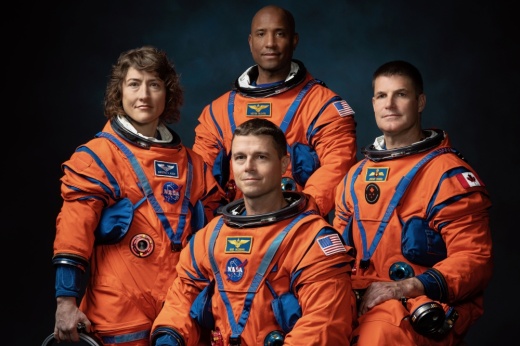During a livestreamed event April 3 at Ellington Field near NASA’s Johnson Space Center in Clear Lake, Houston, NASA officials announced the four astronauts who will be part of Artemis 2, a 2024 mission that will take humans around the moon.
The four astronauts are Reid Wiseman, mission commander; Glover, mission pilot; and Christina Hammock Koch and Jeremy Hansen, mission specialists. Hansen, Glover and Koch are NASA astronauts, and Hansen is a Canadian Space Agency astronaut.
From all the missions from the 1960s to today to all the teams around the world that contribute to the aerospace industry, countless others have made the next step possible, Glover said. Now Glover and three other astronauts have the baton, and they will make the world proud, Glover said.
“This is a big day. We have a lot to celebrate,” he said.
All three NASA astronauts have already spent time in space.
According to a NASA press release, Wiseman previously lived aboard the International Space Station from May through November 2014. Glover previously served as pilot of NASA’s SpaceX Crew-1 mission to the ISS.
Koch served as flight engineer on the ISS on several missions, spending a total of 328 days in space. Artemis 2 will be Hansen’s first trip to space, the release said.
Many NASA astronauts live in the Clear Lake area of Houston and train at the Johnson Space Center.
During Artemis 2, Koch said she and her three teammates will ride in the Orion spacecraft atop the Space Launch System, NASA’s most powerful rocket to date, for eight minutes and then stay high in orbit, tens of thousands of miles above the Earth, testing various systems. If everything checks out, they will begin a four-day journey nearly 250,000 miles to the moon and fly around it, Koch said.
On the return to Earth, they will reach speeds of 25,000 mph in Earth’s atmosphere before splashing down in the ocean, Koch said. In total, the mission will last 10 days.
According to the release, the Artemis 2 mission will test Orion’s life-support systems as well as the capabilities and techniques necessary for humans to live and work on and around the moon.
“This is a global effort, Artemis 2,” Wiseman said while thanking several organizations and people during the event.
Artemis 1, which completed in December, was an uncrewed mission around the moon to test the SLS and Orion. The last crewed mission to the moon was Apollo 17 in 1972.
NASA’s goal is to send humans to the lunar surface. Eventually, the space agency wants astronauts to live and work on the moon and on the Gateway, a space station that will orbit the moon.
By living on and studying the moon, astronauts will prepare for the next goal: flying to Mars.





